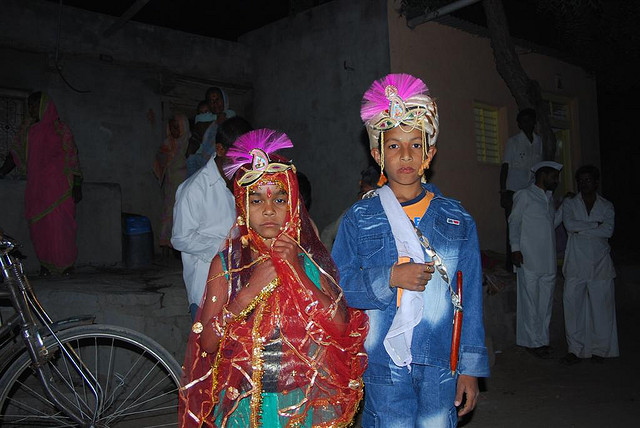India’s 240 Million Child Brides, A Third Of Globe
A recent United Nations Children’s Fund (UNICEF)report said 720 million women around the world, alive today, were married before 18 years compared to 156 million men. One-third of these are in India – about 240 million.
The report focussed on child marriages and women affected by the practice. (The UNICEF report has done a two-fold level analysis of child marriages below 15 years of age and child marriages below 18 years of age, which is also the legal age of marriage in most countries. But for the purpose of this report, we have taken the data together for all marriages under 18 years of age.)
IndiaSpend had earlier reported on child brides in India. India is ranked 6th among the top 10 countries based on high rates of child marriages among women. The table below shows the percentage of women in the age group of 20 and 49 years who were married before 18 years. The corresponding female-to-male ratio of Human Development Index (HDI) 2012-13 is also given in the table.
If we compare countries with high child marriage rates, their female HDI ratio is lower than the world average except in Burkina Faso. The data clearly brings out the correlation between child marriage and lower development of women.
The report, however, concludes that the trend of child marriages has been declining globally, especially the trend of marriages below age 15. But the report has some serious implications for India. There is an interesting finding of the UNICEF study: one-third of the child brides of the world are from India. That could well be the fact given the high population of the country and greater proportion of population living in rural areas with low levels of literacy.
UNICEF had earlier released a report in 2012 on child marriages in India. Early marriage, other than lower level of educational attainment, is also the cause for poor maternal health and higher infant mortality rates. Child-bearing at a young age is detrimental to the health of both the mother and the infant. National Family Health Survey (NFHS 3) shows the rate of child bearing in girls aged 15-19 years.
| Total | Rural | Urban |
| 16 | 19.1 | 8.7 |
Source: UNICEF
Data shows that 16% or one in six girls in that age group have started bearing children. This is the reason why child marriage affects women more than men other than the fact that men are less likely to be getting married as children.
Let us now look at maternal and infant mortality ratios and reduction targets from the latest Census reports.

Source: Census 2011

Source: Census 2011
Maternal mortality rate (the number of women who die during pregnancy and childbirth per 100,000 live births) has declined only marginally from 254 in 2006 to 212 in 2009. The target set by the Government for next year i.e. 2015 is 109.
Infant mortality rate (estimated number of infant deaths for every 1,000 live births) has come down from 68 in 2000 to 50 in 2009. The target for 2015 is 28, which shows the extent of ground that needs to be covered to meet the target.
These indicators establish that early child marriage is adding up to the already existing problems of undernourishment in India. So, how prevalent is child marriage among men and women in India? The table below shows the rate of child marriages in India across various age groups. The rate of child marriage has been declining at more or less the same rate for both men and women. The gap in percentage points between the 45-49 age group and the 25-29 age group between men and women child marriages has not changed significantly.
We tried to find a link between school enrolment among boys and girls and child marriages in India. The most recent flash statistics from the District Information System for Education (DISE) for secondary and higher secondary net enrolment for girls and boys shows a positive trend. While the rates of enrolment in India in secondary education are very low, the gap between girls and boys is not very high.

Source: DISE
The UNICEF report on child marriage in India also shows similar trends for school dropout rates. Given the higher rate of child marriage among girls in India, there should have been a similar gap in the enrolment rate or dropout rates but that is not the case. However, 23% net enrolment ratio in higher secondary level is an issue of concern.
Conclusion
So, it can be concluded that child marriages are affecting the maternal and infant health in India more than educational attainment. All indicators show a dismal picture of maternal and child health in India. The culture of child marriages is an additional social issue to be dealt with by policy-makers.
Image Credit: Flickr



